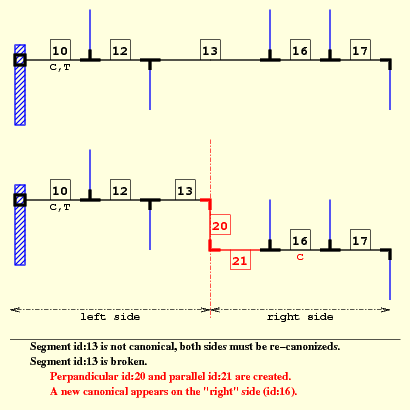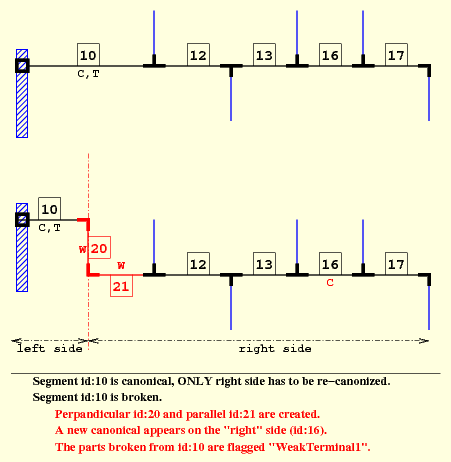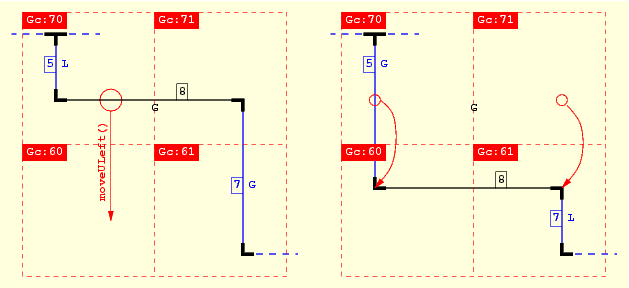Concrete Vertical AutoSegment. More...

Public Member Functions | |
| virtual bool | _canSlacken () const |
| virtual bool | canMoveULeft (float reserve=0.0) const |
| virtual bool | canMoveURight (float reserve=0.0) const |
| virtual Segment * | base () |
| virtual Segment * | base () const |
| virtual Vertical * | getVertical () |
| virtual DbU::Unit | getSourceU () const |
| virtual DbU::Unit | getTargetU () const |
| virtual DbU::Unit | getDuSource () const |
| virtual DbU::Unit | getDuTarget () const |
| virtual Interval | getSpanU () const |
| virtual bool | getConstraints (DbU::Unit &min, DbU::Unit &max) const |
| virtual Interval | getSourceConstraints (unsigned int flags=0) const |
| virtual Interval | getTargetConstraints (unsigned int flags=0) const |
| virtual unsigned int | getDirection () const |
| virtual size_t | getGCells (vector< GCell *> &) const |
| virtual void | setDuSource (DbU::Unit) |
| virtual void | setDuTarget (DbU::Unit) |
| virtual void | updateOrient () |
| virtual void | updatePositions () |
| virtual bool | checkPositions () const |
| virtual bool | checkConstraints () const |
| virtual unsigned int | _makeDogleg (GCell *, unsigned int flags) |
| virtual bool | moveULeft () |
| virtual bool | moveURight () |
 Public Member Functions inherited from AutoSegment Public Member Functions inherited from AutoSegment | |
| virtual Horizontal * | getHorizontal () |
| Cell * | getCell () const |
| Net * | getNet () const |
| const Layer * | getLayer () const |
| Box | getBoundingBox () const |
| Hook * | getSourceHook () |
| Hook * | getTargetHook () |
| Contact * | getSource () const |
| Contact * | getTarget () const |
| Component * | getOppositeAnchor (Component *) const |
| Components | getAnchors () const |
| virtual DbU::Unit | getX () const |
| virtual DbU::Unit | getY () const |
| DbU::Unit | getWidth () const |
| DbU::Unit | getLength () const |
| DbU::Unit | getSourcePosition () const |
| DbU::Unit | getTargetPosition () const |
| DbU::Unit | getSourceX () const |
| DbU::Unit | getSourceY () const |
| DbU::Unit | getTargetX () const |
| DbU::Unit | getTargetY () const |
| void | invert () |
| void | setLayer (const Layer *) |
| bool | isHorizontal () const |
| bool | isVertical () const |
| bool | isGlobal () const |
| bool | isLocal () const |
| bool | isFixed () const |
| bool | isBipoint () const |
| bool | isWeakTerminal () const |
| bool | isStrongTerminal (unsigned int flags=0) const |
| bool | isLayerChange () const |
| bool | isSpinTop () const |
| bool | isSpinBottom () const |
| bool | isSpinTopOrBottom () const |
| bool | isReduced () const |
| bool | isStrap () const |
| bool | isDogleg () const |
| bool | isInvalidated () const |
| bool | isInvalidatedLayer () const |
| bool | isCreated () const |
| bool | isCanonical () const |
| bool | isUnsetAxis () const |
| bool | isSlackened () const |
| bool | canReduce () const |
| bool | mustRaise () const |
| unsigned int | canDogleg (Interval) |
| bool | canMoveUp (float reserve=0.0, unsigned int flags=0) const |
| bool | canPivotUp (float reserve=0.0, unsigned int flags=0) const |
| bool | canPivotDown (float reserve=0.0, unsigned int flags=0) const |
| bool | canSlacken (unsigned int flags=0) const |
| unsigned long | getId () const |
| GCell * | getGCell () const |
| AutoContact * | getAutoSource () const |
| AutoContact * | getAutoTarget () const |
| AutoContact * | getOppositeAnchor (AutoContact *) const |
| size_t | getPerpandicularsBound (set< AutoSegment *> &) |
| AutoSegment * | getParent () const |
| DbU::Unit | getAxis () const |
| DbU::Unit | getOrigin () const |
| DbU::Unit | getExtremity () const |
| Interval | getMinSpanU () const |
| bool | getConstraints (Interval &i) const |
| const Interval & | getUserConstraints () const |
| virtual DbU::Unit | getSlack () const |
| DbU::Unit | getOptimalMin () const |
| DbU::Unit | getOptimalMax () const |
| Interval & | getOptimal (Interval &i) const |
| virtual DbU::Unit | getCost (DbU::Unit axis) const |
| virtual AutoSegment * | getCanonical (DbU::Unit &min, DbU::Unit &max) |
| AutoSegment * | getCanonical (Interval &i) |
| void | unsetFlags (unsigned int) |
| void | setFlags (unsigned int) |
| void | computeTerminal () |
| void | mergeUserConstraints (const Interval &) |
| void | resetUserConstraints () |
| void | setOptimalMin (DbU::Unit min) |
| void | setOptimalMax (DbU::Unit max) |
| void | revalidate () |
| AutoSegment * | makeDogleg (AutoContact *) |
| unsigned int | makeDogleg (Interval, unsigned int flags=KbNoFlags) |
| unsigned int | makeDogleg (GCell *, unsigned int flags=KbNoFlags) |
| bool | slacken (unsigned int flags) |
| bool | reduceDoglegLayer () |
| bool | reduce () |
| bool | raise () |
| AutoSegment * | canonize (unsigned int flags=KbNoFlags) |
| virtual void | invalidate (unsigned int flags=KbPropagate) |
| void | computeOptimal (set< AutoSegment *> &processeds) |
| void | setAxis (DbU::Unit, unsigned int flags=KbNoFlags) |
| bool | toConstraintAxis (unsigned int flags=KbRealignate) |
| bool | toOptimalAxis (unsigned int flags=KbRealignate) |
| AutoSegments | getOnSourceContact (unsigned int direction) |
| AutoSegments | getOnTargetContact (unsigned int direction) |
| AutoSegments | getAligneds (unsigned int flags=KbNoFlags) |
| AutoSegments | getPerpandiculars () |
Protected Member Functions | |
| virtual void | _postCreate () |
| virtual void | _preDestroy () |
 Protected Member Functions inherited from AutoSegment Protected Member Functions inherited from AutoSegment | |
| AutoSegment (Segment *segment) | |
| virtual | ~AutoSegment () |
| void | _invalidate () |
| unsigned int | _getFlags () const |
Additional Inherited Members | |
 Static Public Member Functions inherited from AutoSegment Static Public Member Functions inherited from AutoSegment | |
| static AutoSegment * | create (AutoContact *source, AutoContact *target, Segment *hurricaneSegment) |
| static AutoSegment * | create (AutoContact *source, AutoContact *target, unsigned int dir, size_t depth=RoutingGauge::nlayerdepth) |
 Static Protected Member Functions inherited from AutoSegment Static Protected Member Functions inherited from AutoSegment | |
| static void | _preCreate (AutoContact *source, AutoContact *target) |
Detailed Description
Concrete Vertical AutoSegment.
Member Function Documentation
◆ _canSlacken()
|
virtual |
Returns: true if the segment can be slackened. That is, source or target constraints are less than three pitches.
Implements AutoSegment.
References Interval::contains(), AutoSegment::getAutoSource(), AutoSegment::getAutoTarget(), AutoContact::getGCell(), GCell::getSide(), Interval::inflate(), and Katabatic::KbHorizontal.
◆ canMoveULeft()
|
virtual |
- Returns
- true if the global segment can be moved on the left GCell (for a vertical) or down (for an horizontal). The move is accepted only if it do not change the amount of global wiring. Thus the following conditions:
- The segment mustn't be on the leftmost GCell (obvious...).
- The segment must be global.
- The source and target contacts must be AutoContactTurn(s).
- At least one of the perpandicular must be global and connected through the target. That is, it's a global which extends toward left.
- The GCell of maximum density on the left must remains below the current GCell of maximum density, with a margin of
reserve(expressed in total saturation percentage).
Implements AutoSegment.
References AutoSegment::getAutoSource(), AutoSegment::getAutoTarget(), AutoContact::getGCell(), AutoSegment::getGCell(), AutoSegment::getLayer(), RoutingGauge::getLayerDepth(), GCell::getLeft(), Session::getRoutingGauge(), AutoContact::getSegment(), GCell::getUp(), GCell::getWDensity(), and AutoSegment::isGlobal().
◆ canMoveURight()
|
virtual |
- Returns
- true if the global segment can be moved on the right GCell (for a vertical) or up (for an horizontal). The move is accepted only if it do not change the amount of global wiring. Thus the following conditions:
- The segment mustn't be on the leftmost GCell (obvious...).
- The segment must be global.
- The source and target contacts must be AutoContactTurn(s).
- At least one of the perpandicular must be global and connected through the source. That is, it's a global which extends toward right.
- The GCell of maximum density on the left must remains below the current GCell of maximum density, with a margin of
reserve(expressed in total saturation percentage).
Implements AutoSegment.
References AutoSegment::getAutoSource(), AutoSegment::getAutoTarget(), AutoContact::getGCell(), AutoSegment::getGCell(), AutoSegment::getLayer(), RoutingGauge::getLayerDepth(), GCell::getRight(), Session::getRoutingGauge(), AutoContact::getSegment(), GCell::getUp(), GCell::getWDensity(), and AutoSegment::isGlobal().
◆ base() [1/2]
|
virtual |
Returns: the decorated Hurricane::Segment.
Implements AutoSegment.
◆ base() [2/2]
|
virtual |
Returns: the decorated Hurricane::Segment (const flavor).
Implements AutoSegment.
◆ getVertical()
|
virtual |
Returns: If the decorated segment is a Hurricane::Vertical, return it. NULL otherwise.
Reimplemented from AutoSegment.
◆ getSourceU()
|
virtual |
Returns: The AutoSegment uniform source position. (X for an horizontal and Y for a Vertical).
Implements AutoSegment.
References Segment::getSourceY().
◆ getTargetU()
|
virtual |
Returns: The AutoSegment uniform target position. (X for an horizontal and Y for a Vertical).
Implements AutoSegment.
References Segment::getTargetY().
◆ getDuSource()
|
virtual |
Returns: The AutoSegment uniform delta from source. (dX for an horizontal and dY for a Vertical).
Implements AutoSegment.
References Vertical::getDySource().
◆ getDuTarget()
|
virtual |
Returns: The AutoSegment uniform delta from source. (dX for an horizontal and dY for a Vertical).
Implements AutoSegment.
References Vertical::getDyTarget().
◆ getSpanU()
|
virtual |
Returns: The AutoSegment uniform occupying interval (on X for horizontal and on Y for vertical).
Implements AutoSegment.
References Segment::getSourceY(), and Segment::getTargetY().
◆ getConstraints()
Returns: in min & max the allowed range for the segment axis.
Implements AutoSegment.
References AutoSegment::getAutoSource(), AutoSegment::getAutoTarget(), AutoContact::getCBXMax(), AutoContact::getCBXMin(), AutoSegment::getUserConstraints(), and DbU::getValueString().
◆ getSourceConstraints()
|
virtual |
- Returns
- The Interval into witch the source AutoContact can vary. By default all deduced constraints and user constraints are took into account. If
flagscontainsKbNativeConstraintsthe constraint returned is only the enclosing GCell.
Implements AutoSegment.
References AutoSegment::getAutoSource(), Box::getXMax(), Box::getXMin(), and Katabatic::KbNativeConstraints.
◆ getTargetConstraints()
|
virtual |
- Returns
- The Interval into witch the target AutoContact can vary. By default all deduced constraints and user constraints are took into account. If
flagscontainsKbNativeConstraintsthe constraint returned is only the enclosing GCell.
Implements AutoSegment.
References AutoSegment::getAutoTarget(), Box::getXMax(), Box::getXMin(), and Katabatic::KbNativeConstraints.
◆ getDirection()
|
virtual |
Returns: Katabatic::KbHorizontal or Katabatic::KbVertical according to the decorated segment.
Implements AutoSegment.
References Katabatic::KbVertical.
◆ getGCells()
|
virtual |
- Parameters
-
gcells A vector that will be filled by all the GCells that the segment overlap. In increasing order, from source to target.
- Returns
- The vector's size.
Implements AutoSegment.
References AutoSegment::getAutoSource(), AutoSegment::getAutoTarget(), AutoContact::getGCell(), AutoSegment::getGCell(), and GCell::getUp().
◆ setDuSource()
|
virtual |
Set the uniform dU from source anchor (dX for Horizontal, dY for Vertical).
Implements AutoSegment.
◆ setDuTarget()
|
virtual |
Set the uniform dU from target anchor (dX for Horizontal, dY for Vertical).
Implements AutoSegment.
◆ updateOrient()
|
virtual |
Ensure that source is lower than target. Swap them if needed. Swap never occurs on global segment because their source and target anchors are from different GCell, which are already ordered.
Implements AutoSegment.
References Segment::getSourceY(), Segment::getTargetY(), Segment::invert(), Katabatic::SegSourceBottom, Katabatic::SegSourceTop, Katabatic::SegTargetBottom, Katabatic::SegTargetTop, AutoSegment::setFlags(), and AutoSegment::unsetFlags().
◆ updatePositions()
|
virtual |
Update the segment begenning and ending positions. The positions takes into account the extension caps and reflect the real space used by the segment under it's long axis.
Implements AutoSegment.
References Session::getExtensionCap(), AutoSegment::getLayer(), Segment::getSourceY(), and Segment::getTargetY().
◆ checkPositions()
|
virtual |
Returns: true if the relative positions of source & target are coherent. (source <= target).
Implements AutoSegment.
References Session::getExtensionCap(), AutoSegment::getLayer(), Segment::getSourceY(), Segment::getTargetY(), and DbU::getValueString().
◆ checkConstraints()
|
virtual |
Returns: true if the constraint intervel is coherent (non-empty or punctual in the worst case).
Implements AutoSegment.
References AutoSegment::getAutoSource(), AutoSegment::getAutoTarget(), and Interval::intersect().
◆ _makeDogleg()
|
virtual |
This method is the workhorse for the various dogleg and topology restauration methods. It is the atomic method that actually make the dogleg on this segment.
Returns: Katabatic::KbUseAboveLayer if the dogleg is using the above layer (Katabatic::KbUseBelowLayer for the below layer).
Break the current segment in two (a.k.a. making a dogleg).
- The segment is broken inside
doglegGCell. - Two new segments are createds, one perpandicular and one parallel.
- The original segment is always kept attached to the source. (the new parallel fragment is attached to the target).
- The perpandicular segment is in the layer above by default. If we are already on the topmost routing layer, the below layer is used.
- If the segment pass through the breaking GCell, it's axis is set into the center. If the segment is local, the axis is the middle of the segment.
- The Local/Global kind of the original segment is updated. The local/global status is computed by the constructor of the AutoSegment for the perpandicular and the new parallel.
- The terminal state is updated. If the segment is a strong terminal the part that is no longer directly connected to the terminal is demoted to Katabatic::SegWeakTerminal1.
- The perpandicular is obviously a canonical. If the broken segment is canonical, the original is left canonical and only the new parallel is re-canonized. Otherwise, we re-canonise both sets of aligned segments (the one on the source and the one on the target).
- The three segments are added to the session dogleg stack.
After this method call the net topology is guarantee to be valid.


Implements AutoSegment.
References AutoContact::base(), AutoSegment::canonize(), AutoContactTurn::create(), AutoSegment::create(), Session::dogleg(), AutoSegment::getAutoSource(), AutoSegment::getAutoTarget(), Session::getConfiguration(), RoutingGauge::getContactLayer(), AutoContact::getGCell(), Component::getLayer(), AutoSegment::getLayer(), RoutingGauge::getLayerDepth(), Component::getNet(), Session::getRoutingGauge(), RoutingGauge::getRoutingLayer(), AutoSegment::getSourceY(), AutoSegment::getTargetY(), GCell::getUp(), AutoSegment::getX(), GCell::getY(), GCell::getYMax(), AutoContact::invalidate(), AutoSegment::invalidate(), AutoSegment::isCanonical(), AutoSegment::isLocal(), AutoSegment::isSlackened(), AutoSegment::isWeakTerminal(), Katabatic::KbHorizontal, Katabatic::KbUseAboveLayer, Katabatic::KbUseBelowLayer, Katabatic::KbVertical, AutoContact::migrateConstraintBox(), GCell::removeVSegment(), Katabatic::SegCanonical, Katabatic::SegDogleg, Katabatic::SegGlobal, Katabatic::SegNotAligned, Katabatic::SegSlackened, Katabatic::SegWeakTerminal1, AutoSegment::setFlags(), AutoSegment::setLayer(), and AutoSegment::unsetFlags().
◆ moveULeft()
|
virtual |
This function do not manage an aligned set. It applies on this segment only.
Displace an Horizontal or Vertical segment to the GCell below (a.k.a. lower or inferior). Rules for displacement:
- The segment must be connected at both end to a turn contact (we do not want to manage more complex cases for the time beeing).
- And, of course, the segment must not already by on the bottomost GCell...
The displacement take care of:
- Managing the status of the various perpandiculars. The stretched one are made global if needed. The shrinked one made local, if needed.
- The supporting AutoContact (source & target) are changed of GCell.
- If the segment is global, the go-through GCells are updateds.
Returns: true if the move has succeeded.

Implements AutoSegment.
References GCell::addHSegment(), AutoSegment::getAutoSource(), AutoSegment::getAutoTarget(), AutoContact::getGCell(), AutoSegment::getGCell(), GCell::getLeft(), AutoContact::getSegment(), GCell::getSide(), GCell::getUp(), Interval::getVMax(), AutoSegment::isLocal(), Katabatic::KbHorizontal, GCell::removeHSegment(), Katabatic::SegGlobal, AutoSegment::setAxis(), AutoSegment::setFlags(), AutoContact::setGCell(), and AutoSegment::unsetFlags().
◆ moveURight()
|
virtual |
This function do not manage an aligned set. It applies on this segment only.
Displace an Horizontal or Vertical segment to the GCell above (a.k.a. upper or superior). Rules for displacement:
- See also
- AutoSegment::moveULeft() for a complete description.
Implements AutoSegment.
References GCell::addHSegment(), AutoSegment::getAutoSource(), AutoSegment::getAutoTarget(), AutoContact::getGCell(), AutoSegment::getGCell(), GCell::getRight(), AutoContact::getSegment(), GCell::getSide(), GCell::getUp(), DbU::getValueString(), Interval::getVMin(), AutoSegment::isLocal(), Katabatic::KbHorizontal, GCell::removeHSegment(), Katabatic::SegGlobal, AutoSegment::setAxis(), AutoSegment::setFlags(), AutoContact::setGCell(), and AutoSegment::unsetFlags().
◆ _postCreate()
|
protectedvirtual |
In addition to AutoSegment::_postCreate(), detect whether the segment is global or local and register it in the relevant GCells (if needed).
If the segment is anchored directly on a terminal, adjust the axis so it's connected.
Reimplemented from AutoSegment.
References AutoSegment::_postCreate(), GCell::addVSegment(), AutoSegment::getAutoSource(), AutoSegment::getAutoTarget(), AutoContact::getGCell(), GCell::getUp(), Component::getX(), GCell::getY(), Katabatic::SegGlobal, AutoSegment::setFlags(), and AutoContact::setX().
◆ _preDestroy()
|
protectedvirtual |
Perform operations that must be done before the actual destructor is called. Merely whidrawn the AutoSegment from the lookup/Session mechanism.
Reimplemented from AutoSegment.
References AutoSegment::_preDestroy(), AutoSegment::getAutoSource(), AutoSegment::getAutoTarget(), AutoContact::getGCell(), AutoSegment::getId(), GCell::getUp(), GCell::getY(), and GCell::removeVSegment().
The documentation for this class was generated from the following files:
- AutoVertical.h
- AutoVertical.cpp
- AutoVertical.dox